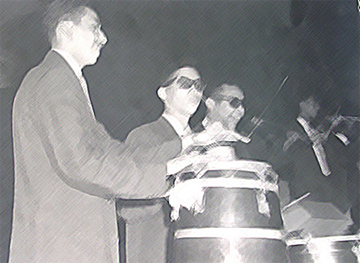Indice - Table of contents
Lo Nuevo[hide]
Reportes: From The St... : Cubadisco 2...
Tienda: Cuban Music Store
Reportes: From The St... : Cubadisco 2...
Fotos: Tom Ehrlich
Staff: Kristina Lim
Musicos: Juan Formell
Musicos: Yordamis Megret Planes
Musicos: Yasser Morejón Pino
Musicos: José Luis "Changuito" Quintana...
Musicos: Dennis Nicles Cobas
Fotos: Eli Silva
Grupos: Ritmo Oriental : 1988 - Vol. IX - 30 a...
Musicos: Rafael Paseiro Monzón
Musicos: Jiovanni Cofiño Sánchez
Fotos Del Día [hide]
The Music of Ritmo Oriental - Lágrimas negras - Matrimonio feliz

1975 Ritmo Oriental - Lágrimas negras (Miguel Matamoros)
bass: Humberto Perera
source: La historia de la Ritmo, Vol. 1
0xx0 0000 xxx0 0000
0xx0 0000 x000 x000
xxx0 xxx0 xxx0 xxx0
xxx0 xx00 x0x0 x00x tumbao 3 -- MIDI-basic
This one is just a chachachá version of the old Matamoros standard, but beautifully played and sung, with interesting harmonic substitutions, and of course Humberto finds ways to tastefully inject a bit of funk and leave his stamp on the proceedings. Here are two ways to notate the fancier version that he plays several times over the course of the track:
 55 bpm - MIDI-with variations
55 bpm - MIDI-with variations
 110 bpm - MIDI-with variations
110 bpm - MIDI-with variations
Many find the second example easier to read, expecially in light of Humberto's double-time figure, and in actual practice it would be written this way, but the first example is technically correct in terms of where the main beats fall.
1975 Ritmo Oriental - Un matrimonio feliz (Roberto Núñez)
bass: Humberto Perera
source: La historia de la Ritmo, Vol. 1
xx0x 0xxx 0xx0 xxx0 2-3 rumba clave
xxxx xxxx xxxx xx0x (bass pickup)
xxx0 0xx0 xxx0 xx0x
xxx0 0xx0 x0x0 x00x bass tumbao -- MIDI
Like hemlines and hairstyles, tumbaos have their fashion trends. The early 70s were a period where nearly every tumbao included the downbeat of the 2-side, but as we get closer to the 80s, we find more and more examples of bombo-ponche, in which the new harmony note, which would be on the downbeat, is struck earlier and allowed to carry over. Un matrimonio feliz is a hybrid which combines this quality with the extra notes and melodicism of the guajeo-based approach. It's also an excellent example of the "singing" bass tumbaos that Arsenio pioneered. If you were to ask someone how this song goes, the person might well answer you by singing this distinct and catchy bassline. Hence Perera varies it much less. However, by the end of the track, he's back to his old tricks, and his brief pedal tone on the 6th degree of the scale is a particularly thrilling way to end our survey of this incredible album.

















